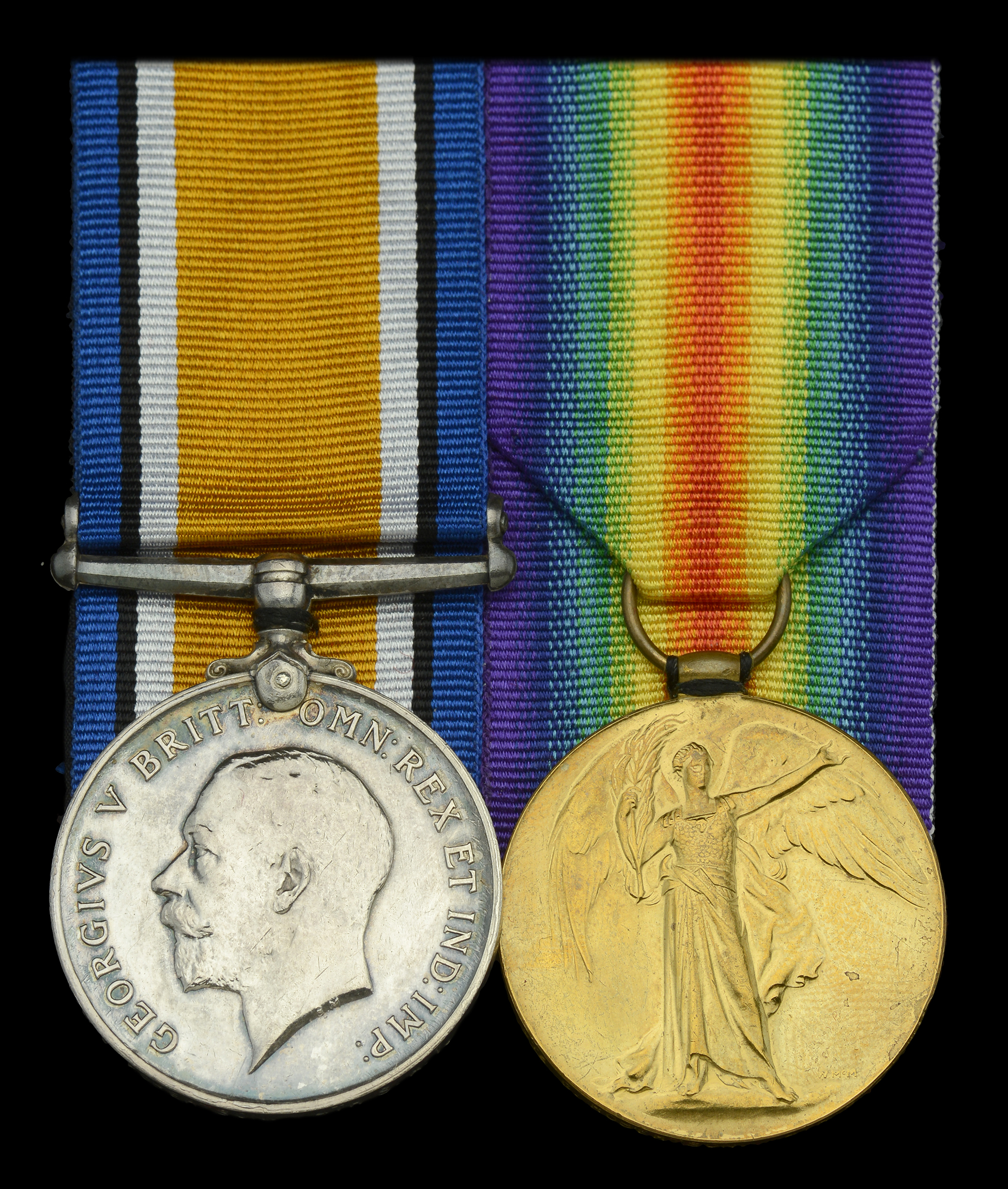Pair: Private G. Robertson, 4th South African Infantry, who suffered gas poisoning at Delville Wood, Somme, on 20 July 1916, and was wounded and taken Prisoner of War at the famous last stand at Marriéres Wood on 24 March 1918 British War and Bilingual Victory Medals (Pte G. Robertson. 4th S.A.I.) mounted for display, edge bruising, otherwise good very fine (2) £200-£240 --- George Robertson was born in Wandsworth, London, with his next of kin being listed as his sister - residing at Jeppestown, Johannesburg, South Africa. Robertson enlisted for the 4th South African Infantry at Potchefstroom in August 1915, and embarked for the UK on 29 September 1915. He served in the French theatre of War from 21 April 1916, and suffered gas poisoning whilst serving with ‘E’ Company at Delville Wood, Somme, on 20 July 1916. After recuperation in the UK, Robertson returned to France on 13 July 1917, and was wounded in action and taken Prisoner of War at Marriéres Wood on 24 March 1918. Possibly the most impressive feat of arms by the South African forces in the War took place in March 1918, when the Germans attacked in Operation Michael. The brigade fought a staunch defence on the first morning of the attack - 21 March 1918 - at Gauche Wood, near Villers Guislain. By 24 March they had carried out a fighting withdrawal to Marriéres Wood near Bouchavesnes and there held on, completely unsupported. They fought on until only some 100 men were left, yet it was only when ammunition ran out that the remainder, many of whom were wounded, surrendered. The following additional details are provided in an article entitled ‘Marriéres Wood 24 March 1918,’ by Andre Crozier, which was published in Military History Journal Vol 18 No 2 - June 2018, of The South African Military History Society: The German Spring Offensive ‘On 21 March 1918 General Ludendorff launched his massive Spring Offensive, Operation Michael, against the British 3rd and 5th Armies in a desperate attempt to win the war before the Americans arrived in force. The South African 1st Infantry Brigade, which formed part of the Scottish 9th Division and of the British 5th Army, held the line at Gauche Wood on the boundary between the 3rd and 5th British Armies. Aided by mist and complete surprise, the offensive started with a tremendous artillery barrage firing gas shells into the rear areas to disrupt the artillery and supply lines. Sixty-five divisions attacked over a 100 km front. The South Africans held on at Gauche Wood but had to withdraw in the afternoon as the division on their southern flank had been pushed back. Everywhere the front was collapsing, with 21 000 British soldiers being taken prisoner on the first day. It looked like Ludendorff had won the war. The South Africans conducted a fighting retreat over three days under the most difficult circumstances, as the units to their flanks kept falling back. Eventually they were ordered to hold 'at all costs' a line at the village of Bouchvesnes on the strategic Peronne - Bapaume road. The brave stand at Marriéres Wood Major-General Dawson was in command, and he conveyed the orders to the South African Brigade, by then reduced to only 500 men. There would be no further retreat. They would stand and fight to the last. Dawson decided to defend a line to the north-west of Marriéres Wood astride a minor road leading from Bouchvesnes to Combles and utilising some old trenches. The battle started at 09.00 on Sunday, 24 March 1918. The South Africans had no artillery support nor support on either flank and were soon surrounded. They were pounded all day by artillery fire and their position was swept with machine gun fire. Their ammunition was rationed and yet they managed to beat off repeated attacks. Eventually, at 16.00, surrounded, with no ammunition and with only about 100 men left, General Dawson decided to surrender. Some men tried to flee, but they were mowed down as the ground to the west was open with no cover.’ Robertson was repatriated from Germany on 26 December 1918. He returned to South Africa in in December the following year, and was discharged in January 1920. Sold with copied service papers.
Auctioneer's Buyers Premium: 24% (+VAT)
There is an additional charge of 4.95% (+VAT/sales tax)
See Full Terms And Conditions





